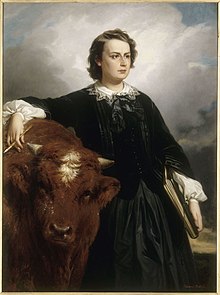Rosa Bonheur was born today, March 16, in 1822. She was a French artist, an animalière (painter of animals) and sculptor, known for her artistic realism. Her most well-known paintings are "Ploughing in the Nivernais," first exhibited at the Paris Salon of 1848, and now at Musée d’Orsay in Paris, and "The Horse Fair," which was exhibited at the Salon of 1853 (finished in 1855) and is now in the Metropolitan Museum of Art, in New York City. Bonheur was widely considered to be the most famous female painter during the 19th century.
 |
| The Horse Fair |
Bonheur moved to Paris in 1828 at the age of 6 with her mother and siblings, her father having gone ahead of them to establish a residence and income. By family accounts, she had been an unruly child and had a difficult time learning to read, though even before she could talk she would sketch for hours at a time with pencil and paper. Her mother taught her to read and write by asking her to choose and draw a different animal for each letter of the alphabet. The artist credits her love of drawing animals to these reading lessons with her mother, who died when she was 11.
At school she was often disruptive, and she was expelled from numerous schools. After a failed apprenticeship with a seamstress at the age of 12, her father undertook to train her as a painter. Her father allowed her to pursue her interest in painting animals by bringing live animals to the family's studio for studying.
Following the traditional art school curriculum of the period, Bonheur began her training by copying images from drawing books and by sketching plaster models. As her training progressed, she made studies of domesticated animals, including horses, sheep, cows, goats, rabbits and other animals in the pastures on the perimeter of Paris, the open fields of Villiers near Levallois-Perret, and the still-wild Bois de Boulogne. At 14, she began to copy paintings at the Louvre.
She studied animal anatomy and osteology in the abattoirs of Paris and by dissecting animals at the École nationale vétérinaire d'Alfort, the National Veterinary Institute in Paris. There she prepared detailed studies that she later used as references for her paintings and sculptures.
 |
Ploughing in the Nivernais
|
Though she was more popular in England than in her native France, she was decorated with the French Legion of Honour by the Empress Eugénie in 1865, and was promoted to Officer of the order in 1894. She was the first female artist to be given this award.
 |
| Edouard Louis Dubufe, Portrait of Bonheur 1857. Symbolic of her work as an Animalière, the artist is shown with a bull. |
Bonheur can be viewed as a "New Woman" of the 19th century; she was known for wearing men's clothing, but she attributed her choice of trousers to their practicality for working with animals.
In her romantic life, she was fairly openly a lesbian; she lived with her first partner, Nathalie Micas, for over 40 years until Micas' death, and later began a relationship with the American painter Anna Elizabeth Klumpke. At a time when lesbian sex–particularly tribadism– was regarded as animalistic and deranged by most French officials, Bonheur's outspokenness about her personal life was groundbreaking.
Bonheur died on May 25, 1899, at the age of 77. She was buried with Nathalie Micas (1824 – June 24, 1889), her lifelong companion at Père Lachaise Cemetery, Paris, and later Klumpke joined them.


No comments:
Post a Comment